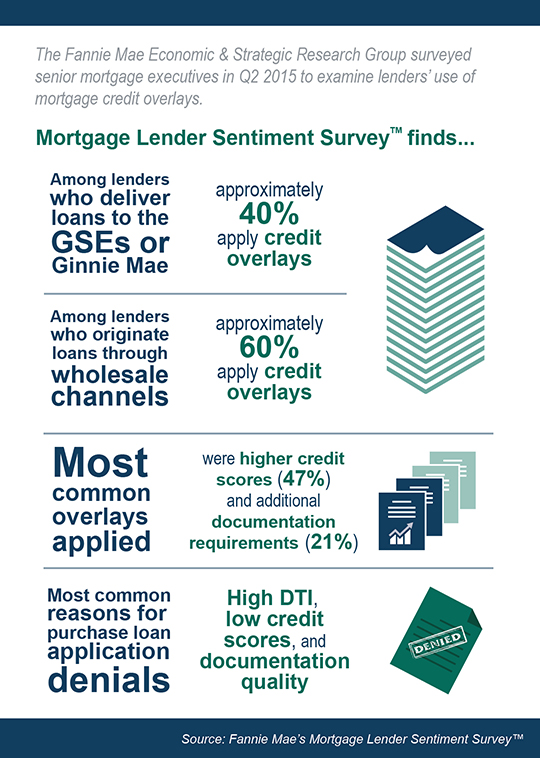Survey Shows Lenders' Limited Credit Overlay Practices
Li-Ning Huang
Senior Manager, Economic & Strategic Research
The U.S. economy has improved significantly since the Great Recession, and mortgage credit standards are loosening gradually.i Nevertheless, the homeownership rate continues to decline and remains currently at the lowest level since 1990. This situation has prompted policymakers, regulators, and industry participants to examine the appropriateness of credit standards and the availability of mortgage credit for American consumers.ii Better understanding lenders’ attitudes about the lending parameters they employ may shed additional light on factors that could make it more viable for lenders to do business within the full credit boxes of the GSEs.
Credit overlays, referring to stricter mortgage approval standards that lenders place above the guidelines set by investors (such as the GSEs), are a potential and often cited factor impacting consumers’ access to mortgage credit. Fannie Mae’s Economic & Strategic Research Group surveyed senior mortgage executives in May 2015 through its quarterly Mortgage Lender Sentiment Survey™ to examine the attitudes of lenders in relation to credit overlays.
Approximately 40 percent of lenders who deliver loans to the GSEs or Ginnie Mae reported applying credit overlays that are more stringent than what the GSEs or Ginnie Mae require. In addition, of lenders who originate or acquire loans through wholesale channels (for example, through mortgage brokers and correspondent lenders), about 60 percent said they apply credit overlays through these channels. When applying credit overlays, 64 percent of lenders who deliver loans to the GSEs or Ginnie Mae said that credit overlays are applied on a limited basis – just 20 percent or less of their loan originations.iii The most common type of overlay applied, as cited by lenders, is higher credit score (47 percent), followed by additional documentation requirements (21 percent), reflecting the impact of the Ability-to-Repay and Qualified Mortgage rule that took effect on January 10, 2014.
Regarding loan application denials, lenders reported a median 10 percent denial rate for both the purchase and refinance markets over the past year.iv Lenders cite high Debt-to-Income (DTI) ratios, low credit scores, and documentation quality as the most common reasons for purchase loan application denials. These results are alike across lender sizes and types. Similarly, for refinance applications, lenders cite high DTI ratios, low credit scores, and insufficient collateral (appraisal issues) as the most common reasons for application denials. These results also are alike across lender sizes and types.
Overall, the survey results suggest that lenders apply credit overlays on a limited basis, but the extent to which they apply credit overlays varies by channel. Correspondent lenders and mortgage brokers are more likely to apply credit overlays than are retail lenders who deliver loans directly to the GSEs or Ginnie Mae. In this study, we did not examine reasons underlying the observed channel difference. There appears to be an opportunity to investigate the dynamics of various factors (e.g., borrower risk, compliance risk, and operational efficiency) in contributing to the differences between retail channels and wholesale channels.

iMortgage Lender Sentiment Survey, Q2 2015, Fannie Mae, https://www.fanniemae.com/portal/research-insights/surveys/mortgage-lender-sentiment-survey.html
The April 2015 Senior Loan Officer Opinion Survey on Bank Lending Practices, https://www.federalreserve.gov/boarddocs/snloansurvey/201505/default.htm.
iiFor details about this industry survey, such as methodology, questionnaires, research report, please see the Mortgage Lender Sentiment Survey web page on fanniemae.com, https://www.fanniemae.com/portal/research-insights/surveys/mortgage-lender-sentiment-survey.html
iiThe State of the Nation's Housing 2015." Joint Center for Housing Studies of Harvard University, https://www.jchs.harvard.edu/sites/jchs.harvard.edu/files/jchs-sonhr-2015-full.pdf "2015 Scorecard for Fannie Mae, Freddie Mac and Common securitization Solutions," The Federal Housing Finance Agency, January, 2015, https://www.fhfa.gov/AboutUs/Reports/ReportDocuments/2015-Scorecard.pdf
iiiThe survey question to estimate the percentage of annual single-family mortgage loan count to which lenders apply credit overlays is asked of retail lenders who deliver loans to the GSEs or Ginnie Mae. We did not ask a similar question for wholesale channels in the study.
ivAccording to the 2013 HMDA (Home Mortgage Disclosure Act) data, the overall denial rate on applications for home-purchase loans across conventional and non-conventional loans is 14.5 percent, while the denial rate for refinance loan applications across conventional and non-conventional loans is 22.7 percent. For details, please see "The 2013 Home Mortgage Disclosure Act Data," Federal Reserve Bulletin, November, 2014, https://www.federalreserve.gov/pubs/bulletin/2014/pdf/2013_HMDA.pdf
Li-Ning Huang, Ph.D.
Senior Manager, Business Strategy
Economic & Strategic Research
The author thanks Doug Duncan, Tom Seidenstein, Mark Palim, Gerry Flood, Steve Deggendorf, David Keil, Wendy Wood, Khristina Waters, and Yana Davidovich for valuable comments in the creation of this commentary and the design of the topic analysis questions. Of course, all errors and omissions remain the responsibility of the author.
Opinions, analyses, estimates, forecasts and other views of Fannie Mae's Economic & Strategic Research (ESR) Group or of survey respondents reflected in this commentary should not be construed as indicating Fannie Mae's business prospects or expected results, are based on a number of assumptions, and are subject to change without notice. How this information affects Fannie Mae will depend on many factors. Although the ESR group bases its opinions, analyses, estimates, forecasts and other views on information it considers reliable, it does not guarantee that the information provided in this commentary is accurate, current or suitable for any particular purpose. Changes in the assumptions or the information underlying these views could produce materially different results. The analyses, opinions, estimates, forecasts and other views published by the ESR group represent the views of that group as of the date indicated and do not necessarily represent the views of Fannie Mae or its management.
The views expressed in this article reflect the personal views of the author, and do not necessarily reflect the views or policies of any other person, including Fannie Mae or its Conservator. Any figures or estimates included in an article are solely the responsibility of the author.
